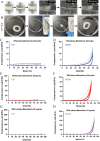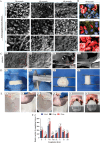Analyzing Mushroom Structural Patterns of a Highly Compressible and Expandable Hemostatic Foam for Gastric Perforation Repair
- PMID: 38439601
- PMCID: PMC11151031
- DOI: 10.1002/advs.202306917
Analyzing Mushroom Structural Patterns of a Highly Compressible and Expandable Hemostatic Foam for Gastric Perforation Repair
Abstract
Nature presents the most beautiful patterns through evolving. Here, a layered porous pattern in golden ratio (0.618) is reported from a type of mushroom -Dictyophora Rubrovalvata stipe (DRS). The hierarchical structure shows a mathematical correlation with the golden ratio. This unique structure leads to superior mechanical properties. The gradient porous structure from outside to innermost endows it with asymmetrical hydrophilicity. A mathematical model is then developed to predict and apply to 3D printed structures. The mushroom is then explored to repair gastric perforation because the stomach is a continuous peristaltic organ, and the perforated site is subject to repeated mechanical movements and pressure changes. At present, endoscopic clipping is ineffective in treating ulcerative perforation with fragile surrounding tissues. Although endoscopic implant occlusion provides a new direction for the treatment of gastric ulcers, but the metal or plastic occluder needs to be removed, requiring a second intervention. Decellularized DRS (DDRS) is found with asymmetric water absorption rate, super-compressive elasticity, shape memory, and biocompatibility, making it a suitable occluder for the gastric perforation. The efficacy in blocking gastric perforation and promoting healing is confirmed by endoscopic observation and tissue analysis during a 2-month study.
Keywords: asymmetric hemostasis; gastric perforation; golden ratio in layered structure; gradient porous structure; mathematic modeling for 3D printing; super‐compressive elasticity.
© 2024 The Authors. Advanced Science published by Wiley‐VCH GmbH.
Conflict of interest statement
The authors declare no conflict of interest.
Figures








Similar articles
-
Endoscopy Deliverable and Mushroom-Cap-Inspired Hyperboloid-Shaped Drug-Laden Bioadhesive Hydrogel for Stomach Perforation Repair.ACS Nano. 2023 Jan 10;17(1):111-126. doi: 10.1021/acsnano.2c05247. Epub 2022 Nov 7. ACS Nano. 2023. PMID: 36343209
-
Layered nanofiber sponge with an improved capacity for promoting blood coagulation and wound healing.Biomaterials. 2019 Jun;204:70-79. doi: 10.1016/j.biomaterials.2019.03.008. Epub 2019 Mar 12. Biomaterials. 2019. PMID: 30901728
-
Super-Elastic Carbonized Mushroom Aerogel for Management of Uncontrolled Hemorrhage.Adv Sci (Weinh). 2023 Jun;10(16):e2207347. doi: 10.1002/advs.202207347. Epub 2023 Apr 10. Adv Sci (Weinh). 2023. PMID: 37035946 Free PMC article.
-
Gastric Perforation following Intragastric Balloon Insertion: Combined Endoscopic and Laparoscopic Approach for Management: Case Series and Review of Literature.Obes Surg. 2016 May;26(5):1127-32. doi: 10.1007/s11695-016-2135-y. Obes Surg. 2016. PMID: 26992895 Review.
-
Recent advances in high-strength and elastic hydrogels for 3D printing in biomedical applications.Acta Biomater. 2019 Sep 1;95:50-59. doi: 10.1016/j.actbio.2019.05.032. Epub 2019 May 22. Acta Biomater. 2019. PMID: 31125728 Free PMC article. Review.
References
-
- Liu S., Luan Z., Wang T., Xu K., Luo Q., Ye S., Wang W., Dan R., Shu Z., Huang Y., ACS Nano. 2022, 17, 111. - PubMed
-
- Verlaan T., Voermans R. P., Henegouwen M. I. v. B., Bemelman W. A., Fockens P., Gastrointestinal Endoscopy. 2015, 82, 618. - PubMed
-
- Lanas A., García‐Rodríguez L. A., Polo‐Tomás M., Ponce M., Alonso‐Abreu I., Perez‐Aisa M. A., Perez‐Gisbert J., Bujanda L., Castro M., Muñoz M., Off. J. American College of Gastroenterology. 2009, 104, 1633. - PubMed
-
- Paspatis G. A., Dumonceau J. M., Barthet M., Meisner S., Repici A., Saunders B. P., Vezakis A., Gonzalez J. M., Turino S. Y., Tsiamoulos Z. P., Fockens P., Hassan C., Endoscopy. 2014, 46, 693. - PubMed
-
- Tarasconi A., Coccolini F., Biffl W., Tomasoni M., Ansaloni L., Picetti E., Molfino S., Shelat V., Cimbanassi S., Weber D., Abu‐Zidan F., Campanile F., Di Saverio S., Baiocchi G., Casella C., Kelly M., Kirkpatrick A., Leppaniemi A., Moore E., Peitzman A., Fraga G., Ceresoli M., Maier R., Wani I., Pattonieri V., Perrone G., Velmahos G., Sugrue M., Sartelli M., Kluger Y., et al., World journal of emergency surgery. 2020, 15, 3. - PMC - PubMed
MeSH terms
Substances
Grants and funding
LinkOut - more resources
Full Text Sources
